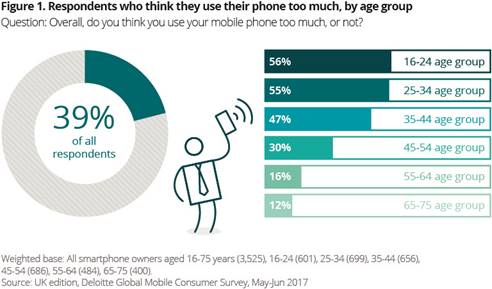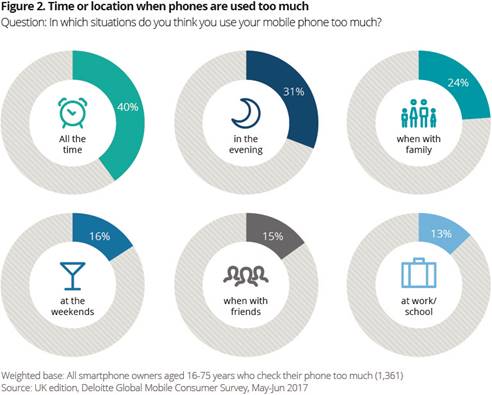 More than half (53%) of 16-75-year-olds in the UK use their smartphones while walking – the equivalent of around 22 million people – according to the latest research from Deloitte. For younger consumers aged 16-24, the proportion rises to 74%. Worryingly, more than 4.5 million people (11% of respondents) also admit to using their smartphones while crossing the road. This proportion almost doubles for 16-24-year-olds (21%).
More than half (53%) of 16-75-year-olds in the UK use their smartphones while walking – the equivalent of around 22 million people – according to the latest research from Deloitte. For younger consumers aged 16-24, the proportion rises to 74%. Worryingly, more than 4.5 million people (11% of respondents) also admit to using their smartphones while crossing the road. This proportion almost doubles for 16-24-year-olds (21%).
Deloitte’s seventh annual Mobile Consumer Survey, State of the smart, which analyses the mobile usage habits of 4,150 people in the UK, has found that 85% of 16-75 year olds now own or have access to a smartphone. This is an increase of four percentage points from 2016 and 33 percentage points from 2012. For 18-24-year-olds, market penetration is at a record 96%.
Paul Lee, head of research for technology, media and telecoms at Deloitte, comments: “Most people can relate to ‘smartphone zombies’, either through being one or bumping into one. But this is just one indication of just how infatuated we are with these devices, for better or worse. While we may be glued to our smartphones, it is important to acknowledge that these devices are also, increasingly, the glue that is binding society together, and will soon become the primary way to communicate, interact and transact with customers and fellow citizens.”
Swipe out
Deloitte’s research shows that the UK’s continued love of smartphones continues to affect almost every aspect of daily life, including night-time. Among 16-19-year-olds, two-thirds (66%) check their phones in the middle of the night, double that of all UK respondents (33%). More than a quarter of ‘screenagers’ (26%) actively respond to messages they receive after falling asleep at night.
More than a third (34%) of respondents look at their smartphones within five minutes of waking, and over half (55%) do so within a quarter of an hour. At the end of the day, more than three-quarters (79%) check their smartphones within the last hour before going to sleep.
 Deloitte’s research also reveals that half of all UK meals taken at home with friends or family, approximately 20 million per week, are disrupted by individuals using their smartphones.
Deloitte’s research also reveals that half of all UK meals taken at home with friends or family, approximately 20 million per week, are disrupted by individuals using their smartphones.
Dan Adams, UK lead partner for telecoms at Deloitte, comments: “If the first 10 years has been about changing our social lives, the next 10 years will be about changing our working lives. The smartphone’s attractiveness lies in the fact that it is the definitive multi-purpose consumer device: a digital Swiss Army knife with a set of tools that is millions of apps deep. Importantly, what goes on behind the smartphone’s screen is only getting smarter through machine learning, facial recognition and other technological advancements, so it is a device that will continue to offer an ever-widening array of benefits and challenges for years to come.”
Call to attention: awareness of usage
For the first time, this year’s research has captured smartphone owners’ self-awareness of their device usage. Two-fifths (38%) of respondents believe that they are using their phone too much –around 15.5 million people. Significantly, this perception is most apparent among younger consumers: 56% of 16-24-year-olds believe they are overusing their phone. By comparison, just 16% of those aged 55-64 think they use their phone too much.
In addition, 60% of parents believe their children use their phone too much, and 41% of respondents in a relationship think their partner is spending too much time on their phone.
Of respondents who believe they use their phone too much, 14% are making an effort to control their usage, and are usually succeeding; 34% are making an effort, but are not normally succeeding and a quarter (26%) are not trying to control their usage, but would like to.
Lee adds: “With every year the smartphone is becoming easier and more enticing to use. The question is: are we at the point at which smartphones have become almost too good for people to cope with, and if so, what remedies might be required? Interestingly, the steps that people are taking to control smartphone usage have a common theme: removing temptation.”
Smartphones: the short form video star
 According to the research, more people are watching video content on their smartphones than ever before. More than half (58%) of smartphone owners watch at least one form of video content on their smartphones every week. In 2012, the proportion was just 18%.
According to the research, more people are watching video content on their smartphones than ever before. More than half (58%) of smartphone owners watch at least one form of video content on their smartphones every week. In 2012, the proportion was just 18%.
Short videos, live posts and stories are watched by 17% of respondents daily, and skews much higher among younger age groups: 54% of 16-19-year-olds watch short form on smartphones at least once a day, and a further 25% do so at least weekly. Longer video content, such as films and TV shows, is viewed weekly by 15% of all respondents, with a fifth of 16-19-year-olds doing so on a daily basis.
Adams concludes: “The smartphone is becoming more important for video. Mobile and fixed operators will need to ensure that their networks are configured to be able to cope with the expected demands that higher video consumption will place. As network bandwidth improves, video could increasingly be streamed into cars, buses and trains for passengers’ consumption, mirroring what has happened with audio streaming.”
Source: Deloitte

You must be logged in to post a comment Login